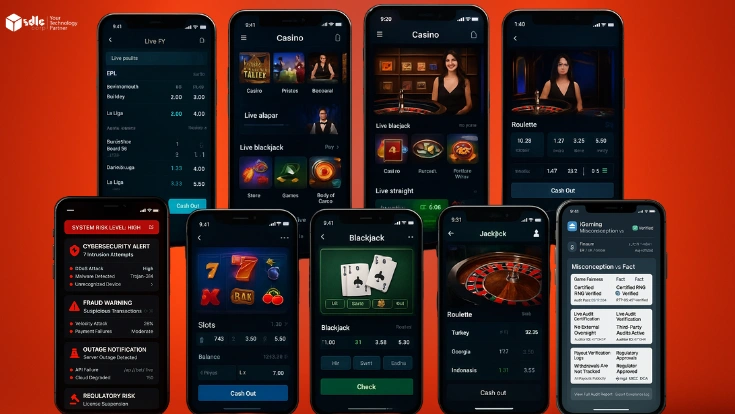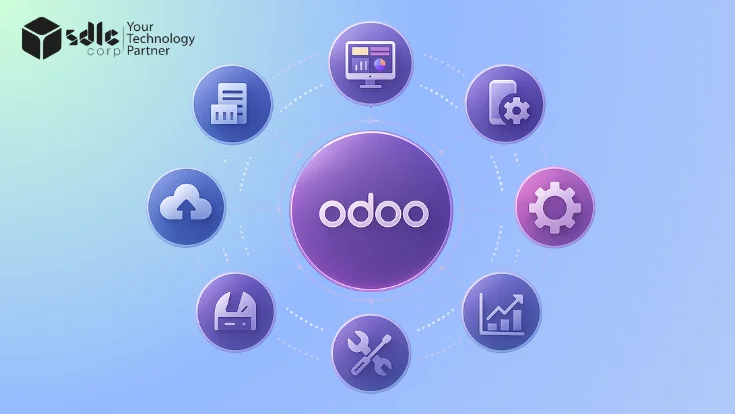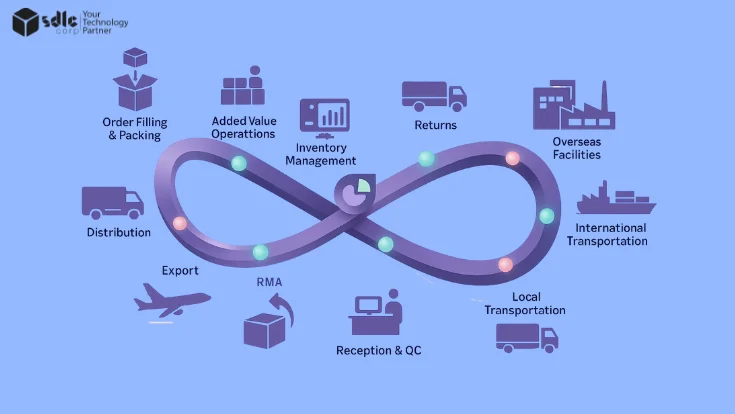Introduction
Game development is a complex, multi phase journey that transforms a simple idea into an interactive, immersive experience. Whether you’re building a mobile app, PC title, or console-based adventure, understanding the key stages of the game development process is essential to delivering a polished product on time and within budget.
In this guide, we’ll walk you through the seven essential stages of game development from ideation and pre production to testing and post-launch support. Whether you’re an indie developer or part of a large studio, mastering this structured approach will help you streamline workflows, reduce errors, and build better games faster.
1. Game Planning and Ideation

Why It Matters: Planning sets the foundation of your game. Without a strong concept and a clear roadmap, development can quickly derail.
Define game genre:
Choose a suitable game genre like Action, Puzzle, or RPG to align gameplay mechanics with player expectations.Set objectives:
Determine whether your game aims to entertain, educate, or monetize to guide feature and content planning.Target audience analysis:
Identify your ideal players based on age, behavior, device preferences, and regional trends to refine your game concept.Platform selection:
Select the right platformmobile, PC, console, or cross-platform to optimize performance and reach your audience effectively.Budget & timeline estimation:
Estimate realistic budgets and timelines to allocate resources properly across all game development stages.Team structure planning:
Outline roles such as developers, designers, and QA testers to streamline workflow throughout the development process.
Explore More How to Create Your Own Video Game: A Step-by-Step Guide
2. Pre-Production

Pre-production transforms your vision into actionable frameworks and documentation, avoiding mid-project confusion.
Game Design Document (GDD):
Create a comprehensive document that outlines gameplay mechanics, storyline, user interface, and technical requirements.Wireframes & Storyboards:
Design detailed visual layouts that map out user interactions, screen flow, and gameplay progression before development begins.Concept Art:
Develop early-stage artwork for characters, environments, and game elements to visualize the creative direction.Monetization Model:
Define how your game will generate revenue through freemium, premium, in app purchases, ads, or subscriptions.Tool Selection:
Select the right game engines and development tools such as Unity or Unreal Engine to align with your game’s scope and platform.
Explore More The Ultimate Guide to Game Development – Tips and Tricks for Beginners
3. Production

The production phase is where your ideas come to life coding, design, and integration of all core features.
Script gameplay logic with C#, C++, or Python:
Write core gameplay functionality using high-performance programming languages tailored to your chosen game engine.Create 2D/3D assets, backgrounds, and effects:
Design visual assets like characters, environments, and visual effects that bring the game world to life.Design levels, challenges, and UI elements:
Build immersive game levels and interactive interfaces that shape the player’s journey and experience.Add multiplayer or server-based functionality:
Implement real-time multiplayer support, matchmaking, and backend logic for connected gameplay.Animate characters and transitions with tools like Spine and Blender:
Use industry tools to create fluid animations for characters, objects, and environmental transitions.
Explore More Game Development Basics: A Beginner’s Guide to Coding
Roles Involved:
Game Developers:
Program the game’s core logic, mechanics, and interactions using game engines and coding frameworks.UI/UX Designers:
Design intuitive user interfaces and user experiences to ensure smooth navigation and player engagement.Animators:
Create character movements, visual transitions, and environment animations that enhance realism and storytelling.Audio Engineers:
Produce sound effects, background music, and voiceovers that enrich the game’s atmosphere and gameplay immersion.QA Testers:
Identify bugs, test functionality, and ensure the game meets quality standards across different devices and platforms.
4. Testing & QA

Testing ensures a polished product and prevents game-breaking issues at launch.
Testing Types:
Alpha Testing:
Conduct internal testing on early game builds to catch core bugs and refine initial functionality.Beta Testing:
Engage external users to gather real-world feedback and identify usability or performance issues before launch.Regression Testing:
Re-test game systems after updates to ensure that new changes don’t negatively impact existing features.Compatibility Testing:
Verify that the game runs smoothly across different platforms, screen sizes, operating systems, and hardware.
QA Tools:
Selenium:
An open-source automation tool primarily used for testing web-based game interfaces and backend dashboards.Appium:
A cross-platform mobile testing framework ideal for automating functional tests in Android and iOS game apps.Unity Test Runner:
A built-in testing tool in Unity that allows developers to write and execute unit tests within the game engine.
Explore More How to Start a Career in Game Development: A Beginner’s Guide
5. Pre-Launch

Marketing and final prep are vital to making your game visible before release.
Build press kits:
Create downloadable press kits including high-quality screenshots, brand assets, and story summaries to support media coverage.Launch landing pages:
Publish SEO-optimized landing pages and blogs to generate organic traffic and build anticipation pre-release.Community engagement:
Foster discussions on platforms like Reddit, Discord, and Twitter to build a loyal player base and gather early feedback.Email campaigns:
Schedule email blasts featuring countdowns, early access links, and exclusive offers to build momentum and pre-orders.Influencer previews:
Collaborate with gaming influencers to release sponsored gameplay content and reach a wider target audience.
Explore More Building a Stellar Game Development Portfolio: Tips and Examples
6. Game Launch

Launch is the culmination of all efforts and directly impacts your market entry.
Release on platforms like Steam, Play Store, App Store:
Deploy the game across major digital distribution platforms to reach your target audience across devices.Real-time monitoring:
Track player behavior, performance metrics, and crash reports to ensure a smooth post-launch experience.Server optimization for peak traffic:
Scale server resources and balance load effectively to handle user spikes during launch.Implement user support channels:
Set up live chat, help desks, and feedback systems to resolve player issues promptly and enhance trust.
Explore More How to Develop a Game Like Bayonetta?
7. Post-Launch Support

Long-term retention and community growth depend on proactive support and content updates.
Release patches and fixes:
Deploy regular updates to resolve bugs, improve performance, and maintain gameplay stability.Launch DLCs, expansions, skins:
Introduce new downloadable content and visual enhancements to keep the player base engaged and monetization active.Host community events and feedback sessions:
Organize in game events and live sessions to encourage participation and collect valuable player insights.Offer 24/7 technical support:
Provide round the clock customer service to address gameplay issues, billing concerns, and technical queries.
Explore More The Future of Gaming: How Web3 Games Are Shaping the Metaverse
Game Development Cost Breakdown
| Stage | Basic Game | Mid-Level Game | Full-Scale Game |
|---|---|---|---|
| Cost | $10K – $15K | $20K – $50K | $50K – $100K+ |
| Timeline | 4–6 weeks | 10–12 weeks | 20–24 weeks |
| Features |
|
|
|
| Monetization | Ad-based only | In-app purchases + Ads | Subscriptions, premium content, and multi-model |
| Testing & QA | Manual playtesting | Automated & beta testing | Full QA pipeline with compatibility testing |
| Post-Launch Support | Basic patches | Regular updates + minor DLC | Content roadmap + live events |
| Technology Stack | Unity / Godot, basic assets | Unity / Unreal, plugin integrations | Full-stack Unity/Unreal, analytics, and backend services |
Technology Stack

Monetization Strategy

Monetization ensures sustainability and growth.
Models:
Freemium with in-app purchases:
Offer the game for free while monetizing through optional in-app purchases like currency, power-ups, or customizations.Premium one-time purchase:
Sell the game at a fixed price upfront, providing full access without ads or microtransactions.Ad-supported gameplay:
Monetize by integrating non-intrusive ads such as rewarded videos, interstitials, or banners within the game.Subscription passes (VIP, Battle Pass):
Provide players with recurring value through time-limited rewards, exclusive content, and progressive upgrades.
Conclusion
Understanding the 7 stages of game development gives you a blueprint for turning ideas into engaging and profitable games. Each phase from planning to post-launch adds value to the overall success of the game. Structured execution and ongoing support from a professional Game Development Company can accelerate your growth and minimize development risks.
Ready to build your dream game? Hire Game Developers from SDLC CORP today!
Fill out our Contact Form and get expert consultation within 24 hours.
FAQ'S
What Are The Main Stages Of Game Development?
The seven main stages are: Planning, Pre-Production, Production, Testing, Pre-Launch, Launch, and Post-Launch Support.


















